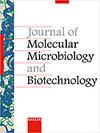Structure and Function of 4-Hydroxyphenylacetate Decarboxylase and Its Cognate Activating Enzyme
IF 1.2
Q2 Biochemistry, Genetics and Molecular Biology
引用次数: 18
Abstract
4-Hydroxyphenylacetate decarboxylase (4Hpad) is the prototype of a new class of Fe-S cluster-dependent glycyl radical enzymes (Fe-S GREs) acting on aromatic compounds. The two-enzyme component system comprises a decarboxylase responsible for substrate conversion and a dedicated activating enzyme (4Hpad-AE). The decarboxylase uses a glycyl/thiyl radical dyad to convert 4-hydroxyphenylacetate into p-cresol (4-methylphenol) by a biologically unprecedented Kolbe-type decarboxylation. In addition to the radical dyad prosthetic group, the decarboxylase unit contains two [4Fe-4S] clusters coordinated by an extra small subunit of unknown function. 4Hpad-AE reductively cleaves S-adenosylmethionine (SAM or AdoMet) at a site-differentiated [4Fe-4S]2+/+ cluster (RS cluster) generating a transient 5′-deoxyadenosyl radical that produces a stable glycyl radical in the decarboxylase by the abstraction of a hydrogen atom. 4Hpad-AE binds up to two auxiliary [4Fe-4S] clusters coordinated by a ferredoxin-like insert that is C-terminal to the RS cluster-binding motif. The ferredoxin-like domain with its two auxiliary clusters is not vital for SAM-dependent glycyl radical formation in the decarboxylase, but facilitates a longer lifetime for the radical. This review describes the 4Hpad and cognate AE families and focuses on the recent advances and open questions concerning the structure, function and mechanism of this novel Fe-S-dependent class of GREs.4-羟基苯乙酸脱羧酶及其同源活化酶的结构与功能
4-羟基苯基乙酸脱羧酶(4Hpad)是一类作用于芳香化合物的Fe-S簇依赖性甘酰基自由基酶(Fe-S GREs)的原型。双酶组分系统包括一个负责底物转化的脱羧酶和一个专用的激活酶(4Hpad-AE)。该脱羧酶利用甘酰基/巯基自由基二偶体将4-羟基苯基乙酸酯转化为对甲酚(4-甲基苯酚),这是生物学上前所未有的kolbe型脱羧。除自由基双配基外,脱羧酶单元包含两个[4Fe-4S]簇,由一个未知功能的额外小亚基协调。4hpade - ae在位点分化的[4Fe-4S]2+/+簇(RS簇)上还原裂解s -腺苷蛋氨酸(SAM或AdoMet),产生瞬时的5 ' -脱氧腺苷自由基,通过抽离氢原子在脱羧酶中产生稳定的甘酰基自由基。4Hpad-AE结合两个辅助[4Fe-4S]簇,这些辅助簇由一个类似铁氧化还原蛋白的插入物协调,该插入物位于RS簇结合基序的c端。铁氧化还原蛋白样结构域及其两个辅助簇对脱羧酶中sam依赖的甘酰基自由基的形成并不重要,但有助于自由基的更长的生存期。本文综述了4Hpad及其同源AE家族,重点介绍了这类新型fe - s依赖性GREs的结构、功能和机制的最新进展和有待解决的问题。
本文章由计算机程序翻译,如有差异,请以英文原文为准。
求助全文
约1分钟内获得全文
求助全文
来源期刊

Journal of Molecular Microbiology and Biotechnology
生物-生物工程与应用微生物
CiteScore
3.90
自引率
0.00%
发文量
0
审稿时长
>12 weeks
期刊介绍:
We are entering a new and exciting era of microbiological study and application. Recent advances in the now established disciplines of genomics, proteomics and bioinformatics, together with extensive cooperation between academic and industrial concerns have brought about an integration of basic and applied microbiology as never before.
 求助内容:
求助内容: 应助结果提醒方式:
应助结果提醒方式:


